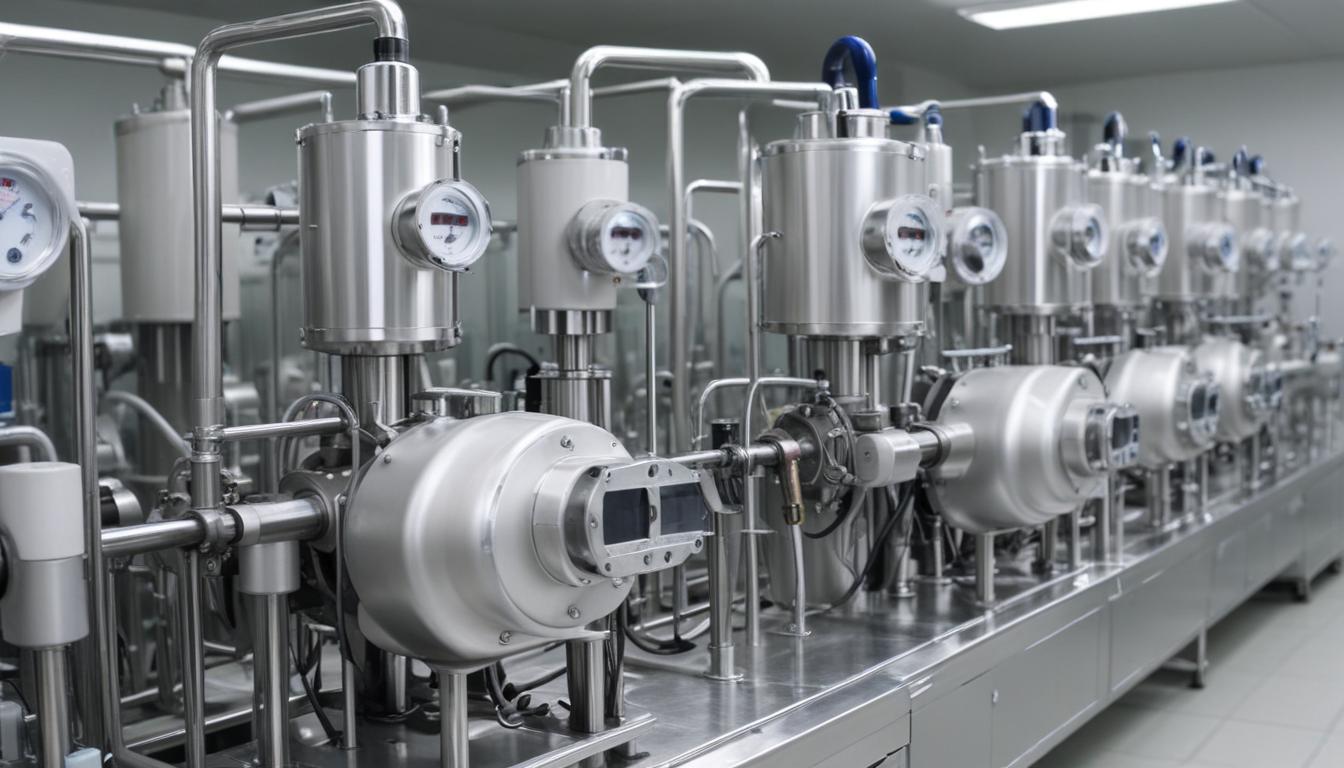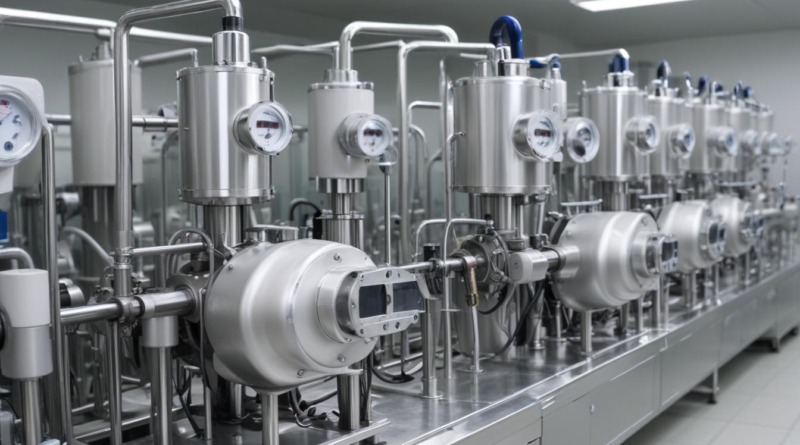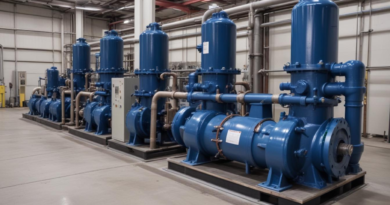pumps used in the cosmetic manufacturing
Cosmetic manufacturing pumps play a crucial role in ensuring the efficient and precise handling of various ingredients throughout the production process. Understanding the different types of pumps available is essential for selecting the appropriate equipment tailored to specific manufacturing needs. Below is an overview of the primary pump types commonly utilized in the cosmetic industry:
| Pump Type | Key Features | Advantages | Typical Applications |
|---|---|---|---|
| Peristaltic Pumps | Utilize rollers to compress a flexible tube, creating a vacuum that moves fluids. | Hygienic, low shear, easy maintenance. | Handling sensitive ingredients, sterilization processes. |
| Gear Pumps | Use interlocking gears to transfer fluids through positive displacement. | High pressure, consistent flow rates. | Viscous liquids, emulsions. |
| Diaphragm Pumps | Operate with a reciprocating diaphragm to displace fluids. | Good for abrasive or corrosive fluids, precise dosing. | Transfer of active ingredients, cleaning agents. |
| Magnetic Drive Pumps | Feature a magnetic coupling that eliminates the need for seals. | Leak-free operation, reduced contamination risk. | Handling hazardous materials, sterile environments. |
| Centrifugal Pumps | Use rotational energy to impart velocity to fluids, converting it to flow. | High flow rates, energy-efficient. | Water-based formulations, large batch processing. |
- Peristaltic Pumps: Ideal for applications requiring gentle handling of delicate ingredients, minimizing shear stress.
- Gear Pumps: Suitable for transporting thick, viscous materials without pulsation.
- Diaphragm Pumps: Offer precise control for metering and dosing active substances.
- Magnetic Drive Pumps: Enhance safety and cleanliness by preventing leaks, essential for high-purity formulations.
- Centrifugal Pumps: Efficiently manage large volumes, making them ideal for bulk manufacturing processes.
Selecting the appropriate pump type depends on various factors, including the viscosity of the product, required flow rate, sensitivity of ingredients, and the necessity for maintaining sterile conditions. By carefully evaluating these aspects, manufacturers can ensure optimal performance and product quality in their cosmetic production lines.
applications in cosmetic manufacturing
In the realm of cosmetic manufacturing pumps, various applications leverage the unique capabilities of different pump types to ensure product consistency, efficiency, and quality. These pumps are integral to multiple stages of the production process, from ingredient handling to final packaging. Below is an in-depth exploration of how different pumps are utilized within the cosmetic industry:
Ingredient Dosing and Mixing
Accurate dosing and thorough mixing of active ingredients are critical for achieving the desired product efficacy and texture. Diaphragm pumps and peristaltic pumps are frequently employed in this stage due to their precision and ability to handle viscous formulations without introducing air bubbles or contaminants.
- Diaphragm Pumps: Provide precise metering, essential for incorporating sensitive active compounds in controlled quantities.
- Peristaltic Pumps: Facilitate gentle transfer of ingredients, minimizing shear stress and preserving ingredient integrity.
Emulsion Formation
Creating stable emulsions, which are foundational in lotions and creams, requires consistent and controlled mixing. Gear pumps and magnetic drive pumps are ideal for this purpose:
- Gear Pumps: Handle thick, viscous mixtures efficiently, ensuring uniform distribution of emulsifiers and preservatives.
- Magnetic Drive Pumps: Offer leak-free operation, maintaining sterile conditions crucial for high-purity cosmetic products.
Filling and Packaging
The filling of containers with the finished product demands high precision to prevent overfilling or underfilling, ensuring customer satisfaction and regulatory compliance. Centrifugal pumps and peristaltic pumps are commonly used in this phase:
- Centrifugal Pumps: Deliver high flow rates necessary for rapid filling of large batches, optimizing production throughput.
- Peristaltic Pumps: Enable precise control over the volume dispensed into each container, reducing waste and ensuring consistency.
Cleaning and Sanitization (CIP/SIP)
Maintaining hygienic manufacturing environments is paramount. Diaphragm pumps are preferred for Clean-In-Place (CIP) and Sterilize-In-Place (SIP) procedures due to their ability to handle aggressive cleaning agents without degradation:
- Diaphragm Pumps: Resistant to corrosive cleaning solutions, ensuring effective sanitization of equipment without contamination risks.
Heat Transfer and Temperature Control
Temperature-sensitive formulations require precise heat transfer to maintain product stability. Centrifugal pumps are utilized in heat exchange systems to regulate the temperature during processing:
- Centrifugal Pumps: Facilitate efficient cooling or heating, ensuring formulations remain within optimal temperature ranges.
Product Transfer and Storage
Transferring products between different stages of production and storing them safely involves reliable pump performance. Magnetic drive pumps and gear pumps are advantageous in these applications:
- Magnetic Drive Pumps: Prevent leaks, ensuring safe transfer of products without exposure to external contaminants.
- Gear Pumps: Efficiently move viscous products between storage tanks and processing units, maintaining flow consistency.
Quality Control Sampling
Periodic sampling for quality assurance necessitates pumps that can handle small volumes with high precision. Peristaltic pumps are ideal for this requirement:
- Peristaltic Pumps: Allow for accurate and contamination-free sampling, critical for maintaining product standards.
Summary of Applications and Suitable Pump Types
The table below outlines key applications in cosmetic manufacturing and the corresponding pump types best suited for each:
| Application | Suitable Pump Types | Reasons |
|---|---|---|
| Ingredient Dosing and Mixing | Diaphragm Pumps, Peristaltic Pumps | Precision, gentle handling of ingredients |
| Emulsion Formation | Gear Pumps, Magnetic Drive Pumps | Consistent mixing, leak-free operation |
| Filling and Packaging | Centrifugal Pumps, Peristaltic Pumps | High flow rates, precise volume control |
| Cleaning and Sanitization | Diaphragm Pumps | Resistance to corrosive agents |
| Heat Transfer and Temperature Control | Centrifugal Pumps | Efficient temperature regulation |
| Product Transfer and Storage | Magnetic Drive Pumps, Gear Pumps | Leak prevention, flow consistency |
| Quality Control Sampling | Peristaltic Pumps | Accurate and contamination-free sampling |
By aligning the specific applications within cosmetic manufacturing with the appropriate types of pumps, manufacturers can enhance operational efficiency, ensure product quality, and maintain regulatory compliance. Selecting the right pump not only streamlines the production process but also safeguards the integrity of the final cosmetic products.
selection criteria
When selecting the appropriate equipment for cosmetic manufacturing pumps, several critical factors must be meticulously evaluated to ensure optimal performance, product quality, and operational efficiency. The following selection criteria are essential considerations for manufacturers aiming to choose the most suitable pump type for their specific needs:
| Criterion | Description | Considerations |
|---|---|---|
| Product Viscosity | The thickness or resistance to flow of the cosmetic formulation. | High-viscosity products may require positive displacement pumps like gear or diaphragm pumps, while low-viscosity liquids can be efficiently handled by centrifugal pumps. |
| Flow Rate Requirements | The volume of product that needs to be moved per unit of time. | Determine whether a high flow rate is necessary for large-scale production or a more controlled, lower flow rate is needed for precise dosing. |
| Chemical Compatibility | The pump’s ability to handle specific ingredients without degradation. | Select materials resistant to the formulation’s active ingredients, solvents, and preservatives to prevent contamination and extend pump lifespan. |
| Hygienic Design | The ease of cleaning and maintenance to maintain sanitary conditions. | Opt for pumps with smooth surfaces, few crevices, and easy disassembly features, such as magnetic drive pumps, to facilitate effective cleaning and reduce contamination risks. |
| Temperature Range | The operating temperature conditions required for processing. | Ensure the pump can operate efficiently within the temperature ranges needed for the formulation, whether heating or cooling is involved. |
| Pressure Requirements | The necessary pressure to move the product through the system. | High-pressure applications may necessitate robust pump types like gear pumps, whereas standard pressure needs can be met with centrifugal or peristaltic pumps. |
| Maintenance and Reliability | The ease of maintaining the pump and its dependability over time. | Choose pumps that offer straightforward maintenance procedures and have a reputation for reliability to minimize downtime and production interruptions. |
| Energy Efficiency | The power consumption relative to the pump’s performance. | Select energy-efficient models to reduce operational costs and support sustainable manufacturing practices. |
| Regulatory Compliance | Adherence to industry standards and regulations. | Ensure the selected pump meets relevant regulatory requirements for cosmetic manufacturing, such as FDA guidelines and Good Manufacturing Practices (GMP). |
| Space and Integration | The physical footprint of the pump and its compatibility with existing systems. | Consider the available space in the production facility and ensure the pump can be seamlessly integrated into the current manufacturing workflow. |
| Cost Considerations | The overall investment required, including initial purchase and long-term operational costs. | Balance the upfront costs with the long-term benefits, such as durability, efficiency, and maintenance expenses, to determine the most cost-effective solution. |
- Evaluate Product Characteristics: Assess the physical and chemical properties of the cosmetic formulations, including viscosity, abrasiveness, and sensitivity to shear forces, to determine the most compatible pump type.
- Assess Production Volume: Align the pump’s capacity with the production scale, ensuring that it can handle peak volumes without compromising on performance or product quality.
- Consider Sterilization and Cleaning Processes: Select pumps that can withstand frequent cleaning cycles and sterilization methods required in cosmetic manufacturing to maintain hygiene standards.
- Analyze Total Cost of Ownership: Factor in not only the initial purchase price but also the costs associated with maintenance, energy consumption, and potential downtime over the pump’s lifecycle.
- Review Supplier Support and Warranty: Choose pumps from reputable suppliers who offer comprehensive support services, including technical assistance, spare parts availability, and favorable warranty terms.
Selection Process Workflow
To streamline the pump selection process, manufacturers can follow a structured workflow:
- Define Requirements: Clearly outline the specific needs of the production process, including flow rates, pressure levels, and product characteristics.
- Identify Suitable Pump Types: Based on the defined requirements, shortlist pump types that align with the operational criteria.
- Compare Specifications: Evaluate the technical specifications of each pump option, considering factors like material compatibility, energy efficiency, and maintenance needs.
- Conduct Cost-Benefit Analysis: Weigh the advantages and costs associated with each pump type to determine the most economically viable option.
- Consult with Manufacturers: Engage with pump suppliers to gain insights, request demonstrations, and obtain expert recommendations tailored to specific applications.
- Finalize Selection: Choose the pump that best meets the operational, financial, and regulatory requirements of the cosmetic manufacturing process.
- Implement and Monitor: Install the selected pump and continuously monitor its performance to ensure it meets the desired standards and make adjustments as necessary.
By meticulously evaluating these selection criteria, cosmetic manufacturers can make informed decisions that enhance production efficiency, ensure product consistency, and maintain high standards of quality and safety in their manufacturing operations.
maintenance and troubleshooting
 Proper upkeep is essential to maintain the efficiency and longevity of cosmetic manufacturing pumps. Regular maintenance not only prevents unexpected downtimes but also ensures consistent product quality and adheres to regulatory standards. Implementing a structured maintenance and troubleshooting program can significantly enhance the reliability of various types of pumps used in the manufacturing process.
Proper upkeep is essential to maintain the efficiency and longevity of cosmetic manufacturing pumps. Regular maintenance not only prevents unexpected downtimes but also ensures consistent product quality and adheres to regulatory standards. Implementing a structured maintenance and troubleshooting program can significantly enhance the reliability of various types of pumps used in the manufacturing process.
Scheduled Maintenance Practices
Establishing a routine maintenance schedule is paramount for the seamless operation of pumps. Key activities include:
- Inspection: Regularly examine pumps for signs of wear, leaks, and corrosion. Visual inspections should be conducted at least weekly, while more comprehensive checks can be monthly or quarterly depending on usage intensity.
- Cleaning: Ensure that all pump components are free from residue and contaminants. This is particularly important for pumps handling active ingredients to prevent cross-contamination. Implement Clean-In-Place (CIP) procedures as necessary.
- Lubrication: Apply appropriate lubricants to moving parts to minimize friction and prevent mechanical failures. Follow the manufacturer’s guidelines for lubrication intervals and types of lubricants suitable for each pump type.
- Calibration: Regularly calibrate pumps to maintain accurate flow rates and dosing precision. Calibration should be performed before each production batch or at least daily in high-precision applications.
- Component Replacement: Replace wear-prone components such as seals, o-rings, and tubing proactively based on the manufacturer’s recommendations or when signs of deterioration appear.
Common Issues and Troubleshooting
Despite regular maintenance, pumps may encounter issues that require prompt troubleshooting to avoid production delays. Below is a table outlining common problems, their possible causes, and recommended solutions:
| Issue | Possible Cause | Solution |
|---|---|---|
| Reduced Flow Rate | Clogged tubing or filters | Inspect and clean or replace tubing and filters regularly to ensure unobstructed flow. |
| Leakage | Worn seals or improper fittings | Replace damaged seals and ensure all connections are securely tightened to prevent leaks. |
| Pulsation in Flow | Worn rollers in peristaltic pumps or air entrainment | Replace rollers and purge the system of air to maintain smooth flow. |
| Overheating | Insufficient lubrication or blocked cooling systems | Ensure proper lubrication and clear any obstructions in cooling pathways to maintain optimal operating temperatures. |
| Noisy Operation | Misaligned components or worn bearings | Realign pump components and replace bearings to eliminate unusual noises. |
| Inconsistent Dosing | Diaphragm fatigue or calibration drift | Inspect and replace fatigued diaphragms and recalibrate the pump to restore dosing accuracy. |
Maintenance Best Practices
Adhering to best practices can enhance the effectiveness of maintenance programs and prolong the lifespan of pumps:
- Documentation: Keep detailed records of all maintenance activities, including inspections, repairs, and part replacements. This facilitates tracking of pump performance and identification of recurring issues.
- Training: Ensure that maintenance personnel are thoroughly trained on the specific types of pumps used in the facility. Understanding the operational nuances of each pump type aids in effective troubleshooting and maintenance.
- Spare Parts Inventory: Maintain an inventory of critical spare parts to enable swift repairs and minimize downtime. Popular components to stock include seals, o-rings, tubing, and bearings.
- Regular Audits: Conduct periodic audits of maintenance practices to ensure compliance with industry standards and identify areas for improvement.
- Use of Quality Components: Utilize high-quality replacement parts and consumables to enhance pump reliability and reduce the frequency of repairs.
- Environmental Control: Maintain a clean and controlled environment around pump installations to prevent contamination and reduce wear from dust and debris.
Implementing Predictive Maintenance
Incorporating predictive maintenance techniques can further optimize pump performance by anticipating failures before they occur. Technologies such as vibration analysis, thermal imaging, and flow monitoring provide real-time data on pump conditions, enabling proactive maintenance actions. By leveraging these advanced methods, cosmetic manufacturers can ensure continuous and efficient pump operation, thereby supporting uninterrupted production processes.
In conclusion, a comprehensive maintenance and troubleshooting strategy is vital for the effective management of cosmetic manufacturing pumps. By adhering to scheduled maintenance practices, promptly addressing common issues, and implementing best practices, manufacturers can achieve sustained pump performance, minimize operational disruptions, and maintain the high quality standards essential in the cosmetic industry.
future trends in pump technology
Advancements in pump technology are continuously shaping the landscape of the cosmetic manufacturing industry. Emerging trends are focused on enhancing efficiency, sustainability, and integration with modern manufacturing practices. These developments promise to address the evolving needs of cosmetic producers, ensuring that cosmetic manufacturing pumps remain pivotal in innovative applications.
Smart and Connected Pumps
The integration of the Internet of Things (IoT) into pump systems is revolutionizing how cosmetic manufacturers monitor and control their processes. Smart pumps equipped with sensors and connectivity capabilities enable real-time data collection and remote monitoring. This facilitates predictive maintenance, reduces downtime, and optimizes performance.
- Real-Time Monitoring: Continuous tracking of pump performance metrics such as flow rate, pressure, and temperature ensures immediate detection of anomalies.
- Remote Diagnostics: Manufacturers can diagnose and troubleshoot issues without physical intervention, enhancing operational efficiency.
- Automated Adjustments: Intelligent pumps can automatically adjust settings based on real-time data, ensuring consistent product quality.
Sustainable and Energy-Efficient Designs
Sustainability is becoming a critical consideration in pump design. Future types of cosmetic manufacturing pumps are expected to prioritize energy efficiency and environmentally friendly materials to reduce the overall carbon footprint of manufacturing processes.
- Energy-Efficient Motors: Incorporating high-efficiency motors and variable speed drives minimizes energy consumption without compromising performance.
- Eco-Friendly Materials: Utilizing recyclable and biodegradable materials in pump construction aligns with the cosmetic industry’s shift toward greener practices.
- Reduced Waste: Advanced pump designs aim to minimize product loss and waste during transfer and processing stages.
Advanced Materials and Durability
The development of new materials enhances the durability and chemical resistance of pumps, making them better suited for handling a wider range of cosmetic formulations. Enhanced materials also contribute to longer pump lifespans and reduced maintenance requirements.
- Corrosion-Resistant Alloys: Use of stainless steel and other corrosion-resistant materials extends pump longevity when dealing with acidic or alkaline formulations.
- Wear-Resistant Components: Incorporating materials that resist wear and tear ensures reliable performance in high-stress applications.
- Flexible Sealing Solutions: Advanced sealing technologies prevent leaks and contamination, maintaining product purity.
Miniaturization and Compact Designs
As production facilities strive for greater efficiency, the demand for smaller, more compact pump systems is increasing. Miniaturized pumps offer several advantages, including reduced space requirements and the ability to integrate seamlessly into automated production lines.
- Space Optimization: Compact pump designs allow for more flexible layout configurations within manufacturing facilities.
- Enhanced Integration: Smaller pumps can be easily integrated into existing systems, facilitating upgrades without extensive reengineering.
- Portable Solutions: Miniaturized pumps provide portability, enabling versatile applications and on-the-go processing capabilities.
Enhanced Precision and Control
Future pump technologies will offer unprecedented levels of precision and control, essential for maintaining the high standards of cosmetic formulations. Enhanced sensor technologies and sophisticated control algorithms contribute to superior dosing accuracy and consistency.
- High-Precision Sensors: Advanced sensors enable exact measurements of flow rates and dosing volumes, ensuring consistent product quality.
- Automated Control Systems: Integration with automated control systems allows for precise adjustments and real-time feedback, enhancing process reliability.
- Improved Accuracy: Enhanced control mechanisms minimize variability in formulations, crucial for achieving desired product characteristics.
Integration with Industry 4.0
The convergence of pump technology with Industry 4.0 principles is driving the adoption of smart manufacturing practices in the cosmetic industry. This integration facilitates seamless data exchange, process automation, and enhanced decision-making capabilities.
- Data Analytics: Leveraging big data analytics helps in optimizing pump performance and forecasting maintenance needs.
- Automated Production Lines: Pumps integrated into fully automated lines contribute to streamlined operations and reduced human intervention.
- Interconnectivity: Enhanced connectivity between pumps and other manufacturing equipment enables coordinated and efficient production workflows.
Customizable and Modular Pump Systems
Future pump designs will emphasize customization and modularity, allowing cosmetic manufacturers to tailor pump systems to specific applications and scale operations as needed. Modular components facilitate easy upgrades and expansions, ensuring that pump systems can evolve with changing production demands.
- Modular Components: Interchangeable parts enable quick modifications and scalability without significant downtime.
- Tailored Solutions: Customizable pump configurations meet the unique requirements of diverse cosmetic formulations and production processes.
- Flexible Scaling: Modular designs allow for incremental scaling, supporting growth and adaptation to market demands.
Table: Emerging Trends in Pump Technology for Cosmetic Manufacturing
| Trend | Description | Benefits |
|---|---|---|
| Smart and Connected Pumps | Integration of IoT for real-time monitoring and remote control. | Enhanced efficiency, predictive maintenance, and reduced downtime. |
| Sustainable and Energy-Efficient Designs | Focus on reducing energy consumption and using eco-friendly materials. | Lower operational costs and reduced environmental impact. |
| Advanced Materials and Durability | Use of corrosion-resistant and wear-resistant materials. | Increased pump lifespan and reliability. |
| Miniaturization and Compact Designs | Development of smaller, space-efficient pump systems. | Optimized facility layout and enhanced integration. |
| Enhanced Precision and Control | Advanced sensors and control algorithms for accurate dosing. | Consistent product quality and reduced formulation variability. |
| Integration with Industry 4.0 | Adoption of smart manufacturing and data analytics. | Streamlined operations and improved decision-making. |
| Customizable and Modular Pump Systems | Flexible and scalable pump configurations. | Adaptability to varying production needs and easy upgrades. |
Conclusion
The future of pump technology in cosmetic manufacturing is poised for significant advancements that will enhance efficiency, sustainability, and integration within modern production environments. By embracing these emerging trends, cosmetic manufacturers can achieve greater operational excellence, maintain high-quality standards, and adapt to the dynamic demands of the industry.




